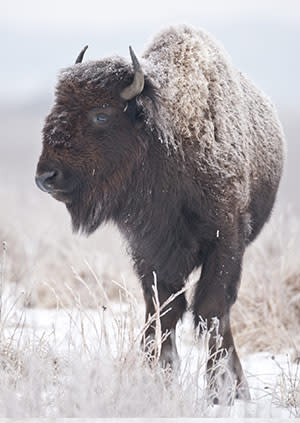Ok, I think my family is ready. We have the woodstove going and plenty of firewood to keep the house warm; our winter coats, hats, mittens, and boots are all by the front door; and we have an extra-large supply of non-perishable goods in our pantry in the event that we get snowed in. Yes, we are ready. Bring on the winter weather!
While making these preparations, I couldn't help but look out at the bison herd grazing at Kankakee Sands and feel a sense of envy. While our family was busily preparing for winter, the bison just ate, slept and wallowed. And it turns out, that's all they need to do to be totally ready for winter.
Bison are well designed for life in the cold and snowy temperatures of winter. Their historic range is from Mexico, continuing north through the U.S., reaching into Canada and extending all the way into Alaska.
Bison have an amazing ability to withstand the cold. In the winter, they grow a thick wooly undercoat of fur. They have eight times as many hair follicles as cattle. The fur is thickest on the bison's head, front of their body and their forelegs. If you have ever had the chance to touch a bison pelt, you lose sight of your fingers when you press them into the thick wool-covered hide.

In the winter, I always put my back to the wind. But that is not the bison's way. With their well-insulated front-side, they chose to face the wind. The wind blows their fur down against their body, creating an impenetrable layer of warmth. In fact, the coat of a bison is so thick and it insulates the bison's body so well, that in winter the snow will land on the bison and not melt from the heat of the bison's body.
Bison have a strong sense of smell. So strong is their sense of smell, that they can smell vegetation under three feet of snow. And with their massive heads, they are able to plow the snow aside to get to the vegetation.
In the winter, bison don't actually need to eat all that much food. Their metabolism slows down in colder months. This is very beneficial as winter is typically a time of year when food is less available. Food moves through the bison's gut more slowly than it does in other grazers; this allows bison to gain more nutritional benefit from less quantity and less quality of forage.
Bison drink approximately 10 gallons of water a day, but even in winter, staying hydrated isn't a problem for bison. They can use their muzzle or their hooves to break through ice to get to water. And if water is not available, they will eat snow to fulfill their water needs.
It's just incredible to me. Bison do not need shelter from the cold of winter. They don't need the woodstove, the hat and mittens, or the non-perishable items in the pantry.
So, on one of the cold and blustery days of winter when we all need a little encouragement, let's bundle up and go admire the bison grazing at Kankakee Sands. They make winter look so easy.
Bison at Kankakee Sands: Pioneers of the Prairie Landscape
The Nature Conservancy's Kankakee Sands is 10,000 acres of prairie and savanna habitat in Northwest Indiana and Northeast Illinois, open every day of the year for public enjoyment. The Nature Conservancy in an international, non-profit organization. For more information about Kankakee Sands, visit www.nature.org/KankakeeSands or call the office at 219-285-2184.



